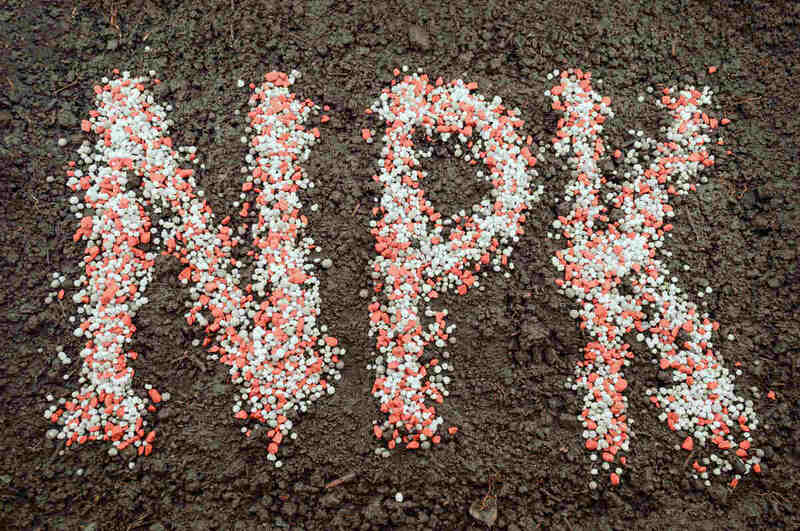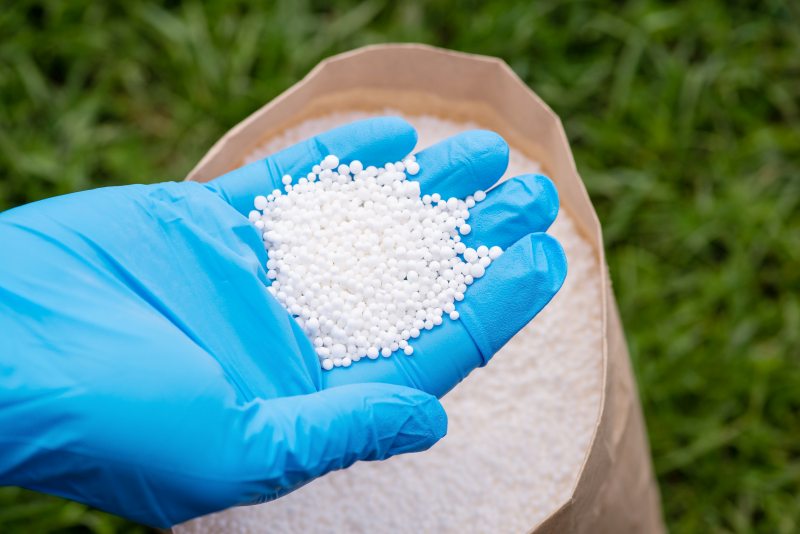
The right fertilizer can transform a sad lawn into gorgeous, thick turf, and fertilizer numbers are the best tool for selecting the perfect nutrient formula for your grass.
A three-number series with dashes in between, the fertilizer numbers tell you upfront how much nitrogen, phosphorus, and potassium is in the fertilizer bag. They help you choose the right nutrient mixture that matches your soil test, season, grass health, and local regulations.
What Does NPK Stand For?
NPK stands for nitrogen (N), phosphorus (P), and potassium (K) — the three primary macronutrients plants need to thrive and grow.
A simple fertilizer definition refers to fertilizers as mixtures of chemical or natural substances you add to the soil to improve its fertility. There are 16 nutrients turfgrass needs to thrive and grow, but three of them are included most often in lawn fertilizers and referred to as the NPK, meaning:
- Nitrogen (N)
- Phosphorus (P)
- Potassium (K).
Nitrogen, phosphorus, and potassium are highlighted on fertilizer bags because they are primary macronutrients. They are needed in large amounts, serve critical plant functions, and are essential for plant growth.
While any of the 16 nutrients can cause problems when in deficit or excess, nitrogen, phosphorus, and potassium are the ones you’ll most often need to apply to your lawn.
Note: If you’d rather not learn about the fertilizer numbers, a lawn treatment professional can help you choose the best fertilizer for your lawn.
See Related: Tell-Tale Signs Your Lawn Needs Fertilizer
What are the Roles of NPK in Fertilizer?

Each of the three primary nutrients is famous for providing specific benefits to turfgrass:
- Nitrogen makes the grass grow faster and greener
- Phosphorus supports strong roots
- Potassium improves turf’s resilience to disease, drought, and other stress factors
But there’s much more these three nutrients do for your lawn.
Nitrogen (N)
Nitrogen is an essential component of chlorophyll (the green pigment), enzymes, amino acids, and proteins in plants. Besides being responsible for the lush green color of healthy grass plants, nitrogen also:
- Supports the growth of new roots, stems, and leaves.
- Helps plants absorb sunlight and produce energy.
- Improves the lawn’s density.
- In the right amounts, it improves stress and disease resistance.
Turfgrass with a nitrogen deficit turns yellow, starting with the older, lower leaves upwards. It also grows slower than it should — you’ll notice this when mowing.
Nitrogen excess, on the other hand, leads to fast growth, but not in a good sense. The plants grow long, weak, and spindly, even though their leaves are a dark, intense green.
Synthetic fertilizers containing quick-release nitrogen (e.g., ammonium nitrate and urea) disperse the nutrient quickly, while slow-release forms (e.g., sulfur-coated urea) provide nitrogen gradually over a longer period.
Organic nitrogen sources are usually slow-release and include seaweed, blood, or feather meal.
See Related:
Phosphorus (P)
Phosphorus is well-known for supporting root growth and its essential role in helping new lawns establish, but it also:
- Helps grass store and use energy.
- Supports the growth of new stems and leaves.
Note: Phosphorus is also essential for plants to mature and make flowers, fruits, and seeds (keep it in mind for your flowering plants and veggies).
Grass lacking phosphorus has dull green or purple leaves, grows slower, and shows weak overall health. Excess phosphorus can limit the absorption of iron and zinc.
Phosphates are the most common source of phosphorus in synthetic fertilizers. Rock phosphate, bone meal, and fish meal are natural sources of phosphorus in organic fertilizers.
Potassium (K)
Potassium’s key role is to improve the plant’s resilience to stress factors. To fulfill its function, potassium:
- Helps plants make reserves for the winter.
- Regulates water uptake and retention, improving drought tolerance.
- Strengthens the cell walls and its resilience to wear and tear.
Note: Potassium also improves fruit quality in fruiting plants, giving fruits a more intense color, flavor, and taste.
When deficient in potassium, turfgrass looks sick and starts to yellow from the lower leaves upwards. Excess potassium is less common but possible. If it happens, it can prevent plants from properly absorbing other nutrients, such as calcium and magnesium.
Potassium in inorganic fertilizers is typically a form of soluble potash (e.g., muriate of potash). Organic sources of potassium include sul-po-mag, kelp meal, and wood ash.
See Related: Organic vs. Synthetic Fertilizer: What’s the Difference?
What is in Fertilizer Besides NPK?
Fertilizers can also include:
- Secondary macronutrients (calcium, sulfur, magnesium)
- Micronutrients (boron, chlorine, copper, iron, manganese, molybdenum, nickel, zinc)
- Inactive ingredients (known as filler), such as limestone, sawdust, or sand, allow the manufacturer to make a product of the desired grade or concentration (fertilizers with a lower concentration have more filler).
If you counted only 13 nutrients instead of 16, know that 3 are not included in fertilizers. Plants also use oxygen, carbon, and hydrogen, but they absorb them from air and water.
What Do Fertilizer Numbers Mean?

Now you know the three fertilizer numbers on the fertilizer bag refer to nitrogen, phosphorus, and potassium, and what each nutrient does for your lawn. But what do the fertilizer numbers mean? It’s quite simple.
The three values separated by dashes indicate the percentages by weight of nitrogen, phosphorus, and potassium in the fertilizer.
Here’s how to read fertilizer numbers with an example. Let’s say you find a fertilizer with an NPK of 20-10-10. This product contains:
- 20% nitrogen
- 10% phosphorus (in the form of phosphate — P2O5 or P2O5)
- 10% potassium (in the form of potash — K2O or K2O)
If it’s a 5-pound fertilizer bag, then it contains:
- 1 pound of nitrogen
- 0.5 pounds of phosphate
- 0.5 pounds of potash
Lower fertilizer numbers indicate a less concentrated product.
For example, some synthetic lawn fertilizers have up to 46% nitrogen and fertilizer numbers such as 46-0-0, while organic lawn fertilizers typically don’t exceed 12% nitrogen.
Complete fertilizers have all fertilizer numbers higher than 0 and are also known as NPK fertilizers.
Balanced fertilizers contain equal or almost equal amounts of all three nutrients (e.g., 10-10-10). Unbalanced fertilizers contain the three nutrients in significantly different quantities. For example, a 16-4-8 ratio indicates a fertilizer high in nitrogen, which is good for turf and shrubs.
When one fertilizer number is 0, it lacks the nutrient in the corresponding position — e.g., a 10-0-4 fertilizer lacks phosphorus. We call fertilizers with 0 in their NPK ratio incomplete fertilizers.
If a fertilizer has two zeros, it includes only one primary macronutrient, known as a straight fertilizer (e.g., 0-0-20 is a potassium fertilizer). Straight fertilizers are great for treating a specific nutrient deficiency.
Higher fertilizer numbers are not necessarily better — it depends on the plant’s needs. However, they do indicate a more concentrated fertilizer that requires a smaller amount to apply.
For example, to apply 1 pound of nitrogen on a lawn or a flower bed, you’ll need:
- 5 pounds of a 20-10-10 fertilizer with 20% nitrogen (20% of 5 pounds equals 1 pound)
- Or 10 pounds of a 10-5-5 fertilizer with 10% nitrogen (10% of 5 pounds equals 1 pound)
See Related:
- 7 Best Fertilizers for Grass [Reviews]
- 7 Best Fertilizers for Bermudagrass [Reviews]
- 7 Best Fertilizers for St. Augustinegrass [Reviews]
How to Choose the Right Fertilizer Numbers for Your Lawn

Understanding fertilizer numbers helps you choose the right lawn fertilizer for your needs. Here’s how to use them.
Start with a soil test: Send a soil sample to the local Extension Office for testing. You’ll receive the results along with a detailed soil analysis and recommendations for correcting the deficiencies.
An example of treatment recommendations would be to apply:
- 4 pounds of nitrogen
- 1 pound of phosphate
- 2 pounds of potash
To comply, you need a fertilizer containing four times more nitrogen than phosphate and two times more potash than phosphate or close to it. We call this a 4-1-2 NPK ratio. In this case, a 16-4-8, 20-5-10, or 24-6-12 fertilizer is a good match.
Pro Tip: Pay attention to the soil pH in the test results. If it’s too high or too low, it might prevent grass from absorbing nutrients. The ideal soil pH for turfgrass is between 6.0 and 7.0.
Consider the lawn’s age: Newly installed lawns, either by seed or by sod, require more phosphorus for root development. According to Penn State University, you need to look for fertilizer numbers with nitrogen and phosphorus values roughly equal, such as 10-10-10, 16-8-8, and 20-10-10.
Check the local regulations. Many states and cities restrict phosphorus and nitrogen fertilizers. For example, in Michigan, you can apply a fertilizer with phosphorus only if you install a new lawn or the soil test shows you need to treat a deficiency.
Consider the season: During the peak growing season, feed the lawn with fertilizers high in nitrogen (e.g., a 20-0-10 fertilizer rate) to support leaf growth.
In late fall, choose NPK numbers with a higher potassium value, like a 21-0-20 or 19-2-13 rate, to improve cold hardiness.
Notice your lawn’s health: If the grass is damaged by a root disease like root rot, a fertilizer with phosphorus can help. If it’s a foliar infestation, like leaf rust, nitrogen can provide better support.
Pro Tip: Avoid overfertilizing the lawn. Excess nutrients can be as damaging as a deficiency.
See Related:
FAQ
You can help the lawn green up more quickly by applying a liquid fertilizer with quick-release nitrogen. Adding liquid iron is also a good option.
The average cost of fertilizing a regular lawn is between $103 and $343, depending on the type of fertilizer used.
Generally, without a soil test, experts recommend a 3-1-2 or 4-1-2 NPK ratio for healthy, established warm-season lawns and a 4-1-2 or a 4-1-3 NPK ratio for cool-season grasses.
Enjoy a Perfect Lawn with Professional Fertilization
Choosing the right fertilizer for your lawn can sometimes become complicated, but you can simplify it with a few clicks on the LawnStarter website. Find a lawn treatment pro near you and let the experts fertilize your lawn to its perfect look and health.
Sources:
- “Lawn Establishment.” By Peter Landschoot, former professor of Turfgrass Science. Penn State University Extension.
- “Lawn Fertilization for Cool Season Grasses.” By Michael Goatley, Extension specialist, Erick H. Ervin, Professor Emeritus, and Steve E. Heckendorn, laboratory manager. Virginia Cooperative Extension.
- Plants: “Effects of Magnesium Imbalance on Root Growth and Nutrient Absorption in Different Genotypes of Vegetable Crops.” By plant nutrition and fertilizer researchers Shuai Qu, Huixia Li, Xueke Zhang, Jingbo Gao, Rui Ma, Ling Ma, and Jing Ma. Plants 2023, 12(20), 3518.
- “Reading A Fertilizer Label.” By Robert F. Polomski, associate Extension specialist. Clemson Cooperative Extension.
- “St. Augustinegrass Lawn Maintenance Calendar.” By Extension specialists Grady Miller, Matt Martin, Jim Kerns, Rick Brandenburg, Terri Billeisen, and Fred Yelverton. North Carolina State University Extension.
- “Turfgrass Fertilization: A Basic Guide for Professional Turfgrass Managers.” By Peter Landschoot, former professor of Turfgrass Science. Penn State University Extension.
- “Understanding Phosphorus Fertilizers.” By Daniel E. Kaiser, Extension nutrient management specialist, and Paulo Pagliari, Extension soil scientist. University of Minnesota Extension.
Photo Credit: ooddysmile / Adobe Stock Free / License